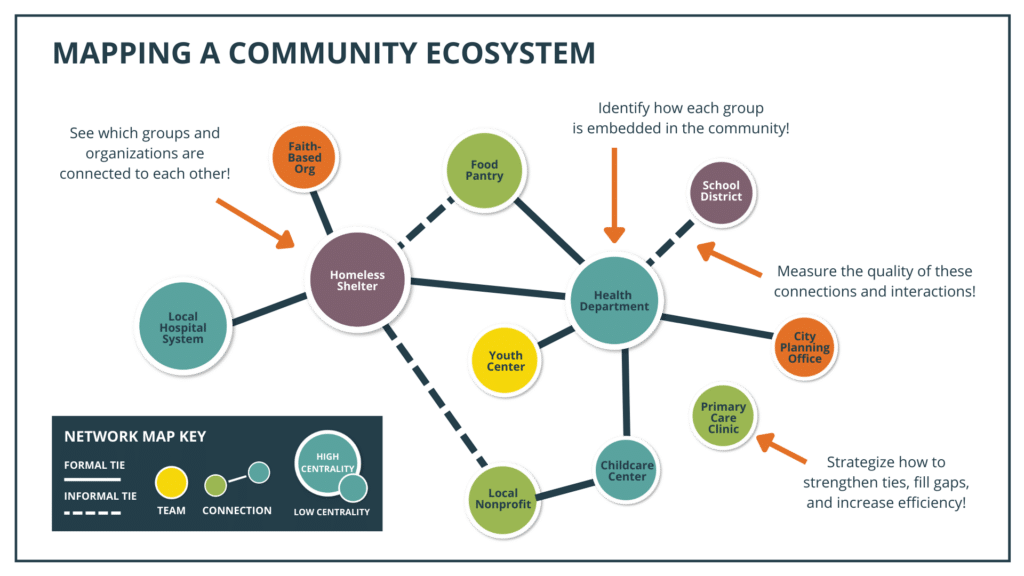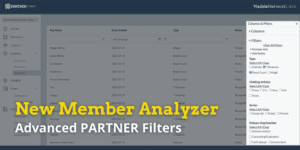In the realm of community collaboration, effective relationship management is crucial for achieving impactful outcomes. Inspired by Customer Relationship Management (CRM) systems, Community Partner Relationship Management (CPRM) offers a unique approach that incorporates systems thinking, Social Network Analysis (SNA), and network science to optimize the management of community partnerships.
This article explores what CPRM is and how it can strategically and effectively enhance collaborative community efforts.
What is CPRM?
CPRM is an advanced platform designed to manage and optimize relationships between organizations and their community partners. While it draws inspiration from traditional CRM systems, CPRM goes beyond by integrating SNA and network science to provide a comprehensive understanding of community networks. This systems perspective allows organizations to manage their collaborations more strategically and effectively, even with limited time and resources.
Key Features of CPRM:
- Network Mapping and Visualization: Visualize and analyze the complex ecosystem of relationships between community partners using social network analysis.
- Network Member Management: Centralize and manage information on your community partners, points of contact, notes, tags, and other custom data across your organization.
- Relationship Management Tools: Track relationship interactions and meetings and metrics like trust and value to manage your partnerships strategically.
- Democratizing Data: CPRM systems make it easy to share your findings back with the community to build capacity and help them leverage their data as well.
The Role of SNA and Network Science in CPRM
SNA is a methodological approach that examines the relationships and interactions within a network. In the context of CPRM, SNA helps organizations understand the structure and dynamics of their community partnerships, revealing patterns of collaboration, key players, and areas needing improvement.
Network Science: Network science provides the theoretical framework and analytical tools to study complex networks. By leveraging network science, CPRM enables organizations to manage their community relationships with a deeper understanding of how network structures impact collaboration and outcomes.

Advantages of CPRM for Community Collaboration
1. Strategic Collaboration: CPRM’s network mapping capabilities allow organizations to visualize their entire network of community partners. This visualization helps identify central nodes and key influencers, enabling more strategic collaboration and coordination.
2. Efficient Resource Allocation: By analyzing the network, organizations can pinpoint where resources are most needed and will be most effective. This ensures that resources are used efficiently, avoiding duplication and maximizing impact.
3. Data-Driven Decision Making: CPRM combines traditional CRM data management with SNA and network science insights. This combination provides a robust data-driven foundation for strategic decision-making, ensuring that actions are based on a comprehensive understanding of the network.
4. Strengthening Relationships: Understanding the strength and quality of relationships within the network allows organizations to focus on building trust and enhancing collaboration. CPRM tools help maintain and improve these relationships over time.
5. Identifying Gaps and Opportunities: Network analysis can reveal gaps where connections are weak or missing. This insight enables organizations to address these gaps by fostering new relationships or strengthening existing ones, thereby expanding the network’s reach and effectiveness.

Get our monthly newsletter with resources for cross-sector collaboration, VNL recommended reading, and upcoming opportunities for engaged in the “network way of working.”
Practical Applications of CPRM in Community Collaboration
Case Study: Health Coalitions A health coalition can use CPRM to map its network of hospitals, clinics, non-profits, and government agencies. By analyzing this network, the coalition can identify central organizations, understand information flow, and pinpoint areas where collaboration is lacking. This strategic approach allows the coalition to enhance partnerships, improve information sharing, and allocate resources more effectively to address community health issues.
Case Study: Educational Networks An educational network comprising schools, universities, and community organizations can utilize CPRM to strengthen collaborations aimed at improving educational outcomes. By visualizing and analyzing the network, the educational network can identify key influencers, streamline communication, and ensure that resources such as training programs and educational materials are distributed where they are most needed.

Conclusion: Understanding CPRM
CPRM, inspired by CRM and enhanced by SNA and network science, is a transformative tool for managing community partner relationships. By providing a comprehensive understanding of network structures and dynamics, CPRM enables organizations to collaborate more strategically, allocate resources efficiently, make data-driven decisions, strengthen relationships, and identify gaps and opportunities.
Leveraging CPRM can significantly improve collaborative community outcomes, making it an essential tool for any organization seeking to drive meaningful impact through strategic partnerships.

Ready to Transform Your Community Partnerships?
Experience the power of strategic collaboration with PARTNER CPRM. Schedule a demo today to see how our platform can help you manage your community partner relationships more effectively, optimize resources, and achieve impactful outcomes.
Don’t miss the opportunity to revolutionize your network management—get started now!







